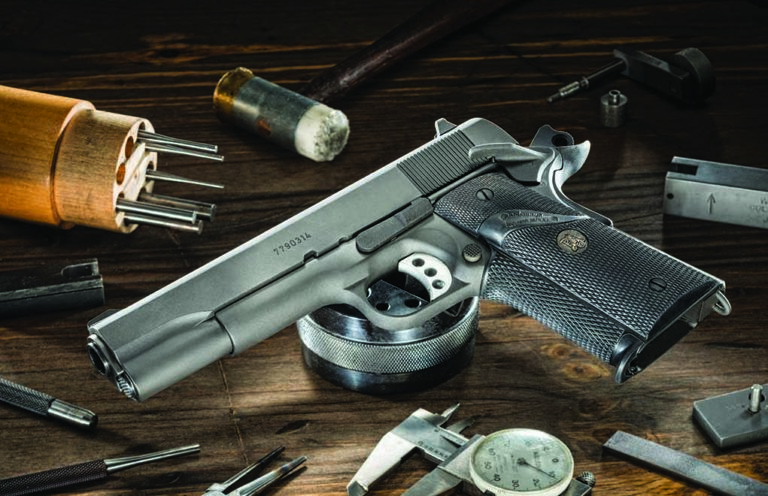
The history and building of one battle-tough pistol — MEUSOC 1911.
What went into the original Variant 1 MEUSOC 1911:
- Introduced in 1987 and manufactured by the 2112s.
- Receivers are USGI M1911A1.
- First slides used were System “hard” slides.
- King's thumb safety.
- Wilson 66 beavertail grip safety.
- Videcki solid stainless-steel trigger.
- Maryland Gun Works (MGI) commander hammer.
- 18.5-pound recoil spring provided by Bar-Sto.
- Primarily Bar-Sto barrels were used.
- Accompanied by Wilson 47 magazines.
Given that I’m a certified 1911-a-holic and I love history, I’m interested in just about every variation of the 1911 pistol out there. Back in the early 2000s, I came across several articles and photographs of the Marine Expeditionary Unit Special Operations Command (MEUSOC) 1911, and I was immediately intrigued. What is this pistol? Who made it? What’s the real-life story behind it?

I kept reading and researching the MEUSOC pistol, and I eventually met retired Marine KC Crawford, who happened to be a former 2112 Armorer in Quantico — and he actually built these pistols. Not only is Crawford an accomplished gunsmith, but he had insight on the inner workings of the 2112 Marine Corps Armorers in Quantico — and he was willing give me a history lesson.
MEUSOC Parts And Variations
Crawford worked at the Quantico Shop in 1987 when the first MEUSOC pistols were introduced and manufactured by the 2112s. He was also fortunate enough to be one of the guys who built those first pistols for the special units that wanted to maintain the 1911 in .45 ACP, instead of the then-new M-9 Beretta 9mm.
The 2112s listened to what the SOC guys wanted, including durable fixed sights, a long trigger, a beavertail grip safety, an ambidextrous thumb safety and an accurate barrel. There were many discussions on what aftermarket parts to put into the new guns, but above all, it had to be a no-BS-bet-your-life-on-it pistol that could stand up to the rigors of combat. After all, it was common for a pistol to have more than 10,000 rounds shot down the tube in training before the gun ever left to go into harm’s way.
After all was said and done, a basic list of modifications was put together — and the build was finalized.
The receivers were all USGI M1911A1. Over the course of time, some Caspian receivers were used, but that was later on in the production cycle. The first slides used were System “hard” slides to ensure a solid platform to work with. The standard GI thumb safety was replaced with an ambidextrous thumb safety. There were a few ambidextrous models made, but the King’s 201 was selected because of the extended hammer pin retention feature that no other manufacturer was using.
More 1911 Posts:
- 4 Reasons Why The 1911 Remains On Top
- Colt 1911 Government Model And Beyond
- 5 Best Models And Calibers Beyond The Usual Colt 1911 .45 ACP
- Tips For Getting Your Perfect Custom 1911
- Classic Guns: The Legendary 1911
Because of the hard-use nature of the pistol and the thumb safety being activated and de-activated thousands of times, the armorers believed that the hammer-pin retention would give a more positive feel of the safety. It also allowed any set of grips to be used because there was no need for the ambidextrous cutout on the right-side grip.
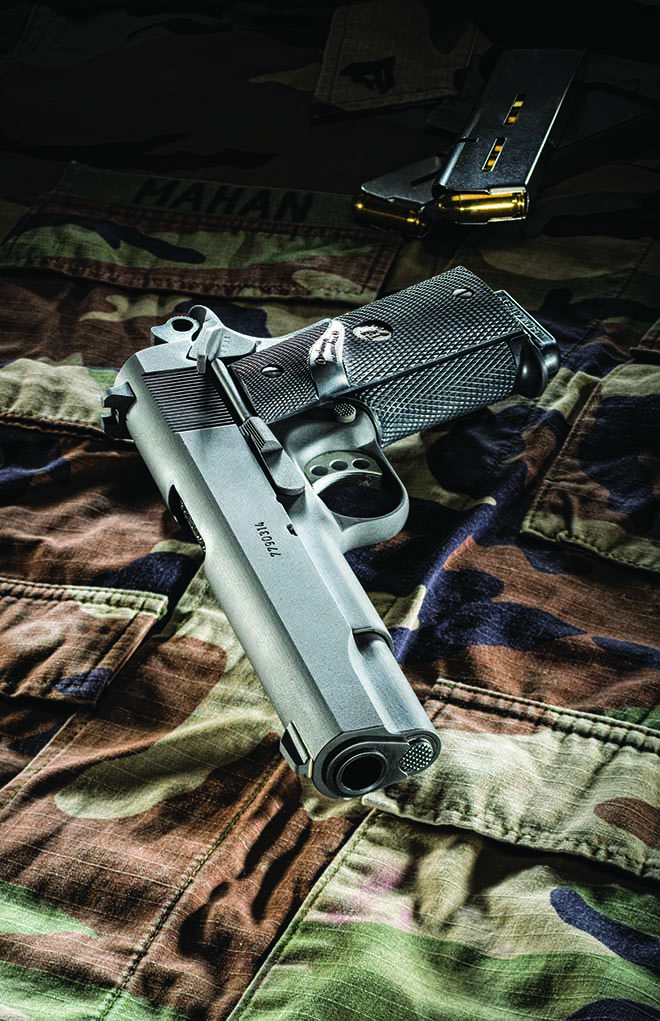
The safety was a cast part, as were most parts back in the day. And, of course, the safeties started having issues rather quickly. While the right lever did stay in place, the joint holding the left and right side together developed a great deal of play and made the safety very sloppy. Many of them eventually broke, leaving the safety inoperable until a new unit could be fit to the pistol.
The beavertail grip safety chosen was the Wilson 66, which used a compound radius, making it more difficult to fit than other options available at the time. There was no such thing as a “memory groove” on a grip safety at that time period, and it became a common practice to tape the grip safety so the gun could shoot without having a perfect grip. The armorers tried to set the grip safeties so they would function with just the slightest depression yet still pass a safety check — sometimes they were successful, and other times not as much. Trying to give the shooters what they wanted while providing a safe and serviceable pistol was their ultimate goal.
The trigger used initially was the Videcki solid stainless-steel unit. The hole for the over-travel screw was welded so there was no over-travel screw to work loose and stop the pistol from firing. This created its own problem by having so much over-travel that some of the pistols had hammer follow issues — and the trigger was so heavy that it was believed to cause sear bounce, creating another set of problems. It was common practice when building the guns to rack the slide, letting it slam forward as many as 15 times in a row. If the hammer followed during this “test,” the gun was sent back.
The trigger pull weight was kept between 4 and 4.5 pounds. It was the shop’s belief that if 4 pounds was good enough for a national match hardball gun, then it should be good enough for the MEUSOC pistol as well. Of course, there’s a big difference between a match pistol that can have maintenance done as needed and a hard-use gun that may not see maintenance for 6 months.
To complete the trigger group, a Maryland Gun Works (MGI) commander hammer was chosen. Disconnectors were system GI and sears were a collection of many different manufacturers. The first sears used were again GI, and as time progressed, various manufacturers’ “hard” sears were used. The belief at the time was that the feel of the trigger should be a “glass rod break.” However, that kind of release normally doesn’t last very long, especially when the trigger components are not the best.
Along that same line, the standard recoil spring was an 18.5-pound unit provided by Bar-Sto. This was a very heavy-duty recoil spring designed to take the abuse and survive a training cycle without having to be replaced. The recoil spring was a stainless-based product that did hold up very well to the rigors presented by the team members in every environment.
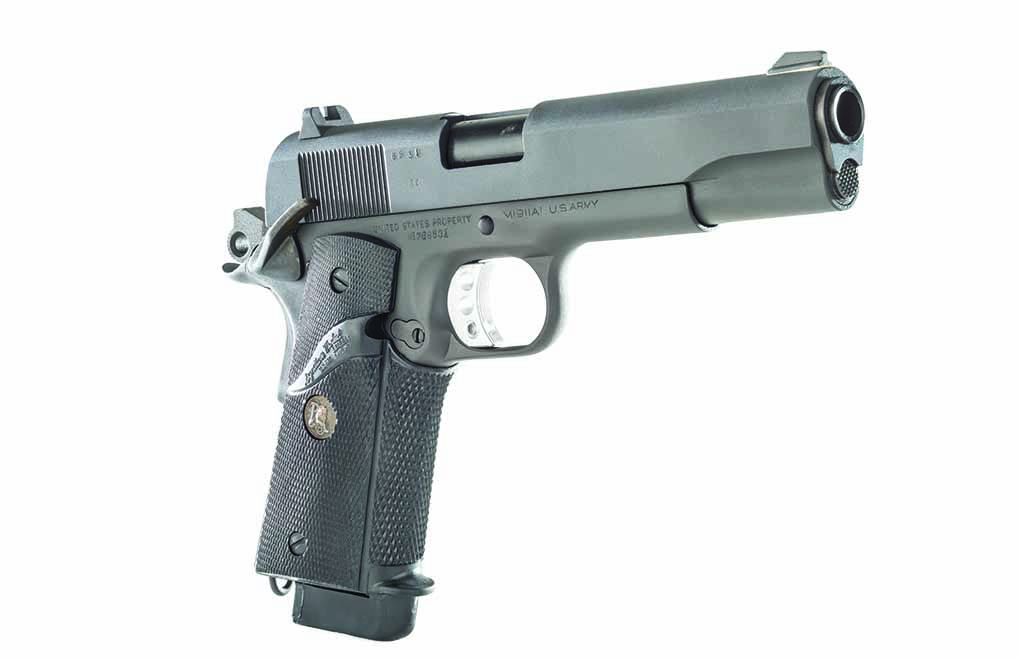
Throughout the early history of the MEUSOC pistol, Bar-Sto barrels were the primary choice. As time progressed, other barrel manufacturers were used. The Bar-Sto barrels the armorers first used were oversized, gunsmith-fit barrels. That didn’t last very long because of the time and training required to fit a barrel, bushing link and pin to a gun that needed some tolerance to remain fully functional.
The armorers then went to the “drop in” barrel offered by Bar-Sto. Of course, we all know that drop-in parts for a 1911 always fit — not. So, the armorers quickly learned that while it was nice to have most of the work done via drop-in parts, many things needed to be checked and properly fit.
Another component requested by the SOC team was a flat mainspring housing. While there were aftermarket flat mainspring housings available, the decision was made to modify and manufacture those springs in-house. The arched housings were cut down to a flat housing configuration and then serrated to give a gripping texture to the back of the pistol. This made it easier for another requirement, a lanyard loop, to be retained from the original housing.
The Variant 1 pistol consisted of a System “hard” slide with standard sight cuts. Many of these slides were the seven-digit 7790314 slides, though a few of the Drake NM7791435 slides were also used. The front sight was a Millett stake-on front using the existing tennon sight cut. Problems were identified early on with the staked front sights shooting loose. Millett soon released the “dual crimp” front sight, which were introduced to the build. This process also failed, and front sights were soldered to ensure complete retention.
The pistols were finished in manganese phosphate, and the stainless-steel Bar-Sto barrels were blackened with bluing salts to create a uniform matte finish. Pachmayr grips accentuated the pistol with a non-slip grip that was easy to maintain. Seven Wilson 47 magazines were the standard accompaniment with each new pistol.
Variant 2 Pistols
These pistols were the start of the rebuild process as guns came back to the shop after a deployment rotation. The pistol remained basically identical to the Variant 1 configuration, with the exception of a Videcki three-hole speed trigger and Springfield Armory slides being introduced as replacement. The manufactured rear sight and soldered Millett front sights were retained.

The slides in use had a variety of markings because of availability at the time of need. The first slides had only vertical rear cocking serrations and “Springfield Armory” stamped on the right side. The left side was marked “MODEL 1911-A1.”
Other slides had forward-slanted, rear-only cocking serrations, crossed cannons to the rear of the ejection port and “Springfield Armory” stamped on the right side. The left side was marked “MODEL 1911-A1,” and centered below that “CAL .45” was stamped. Later slides also had the forward slanted cocking serrations (rear only), “Springfield Armory” stamped and the crossed cannons to the right of Springfield Armory with a lowered ejection port. The left side of the slide was marked “MODEL 1911-A1,” and centered below that “CAL .45.”
Variant 3 Pistols
The bottom end of the Variant 3 pistol remained identical to the original design; however, the slides were upgraded to the Springfield Armory double-serrated forward-slant design with the in-house custom rear sight and the Millett soldered front. “Springfield Armory” was stamped with crossed cannons on the right side, and the slide featured a lowered ejection port. “MODEL 1911-A1” and “CAL .45” was stamped on the left.
By early 2003, the armorers started to Magnaflux all receivers, and any that came back from the fleet were coded out — all the guns built from that point on had an Ed Brown grip safety. At the same time, new Springfield slides with a Novak sight cut were put into service.
Variant 4 Pistols
Variant 4 marks the biggest change to the MEUSOC pistol since its introduction in the late ‘80s. The slide remained the Springfield Armory design with the Novak low-mount sight cut in the rear and a dovetail front. Flat, forward-slanted cocking serrations adorn the front and rear of the slide, as does a lowered and flared ejection port. Markings on the slide remain the same as Variant 3.
At the start of this variation, the King thumb safety was still being used, and a very small amount of Variant 4 guns had been built with Wilson drop-in barrels — all others featured the Bar-Sto semi-drop in barrel. There were also some guns with a Nowlin barrel that came in for maintenance. Nowlin was the barrel chosen when they started the product improvement, but there’s no evidence of them ever being used in mainstream production. Again, there were times that the armorers had to use what they could get to keep the pistols running.
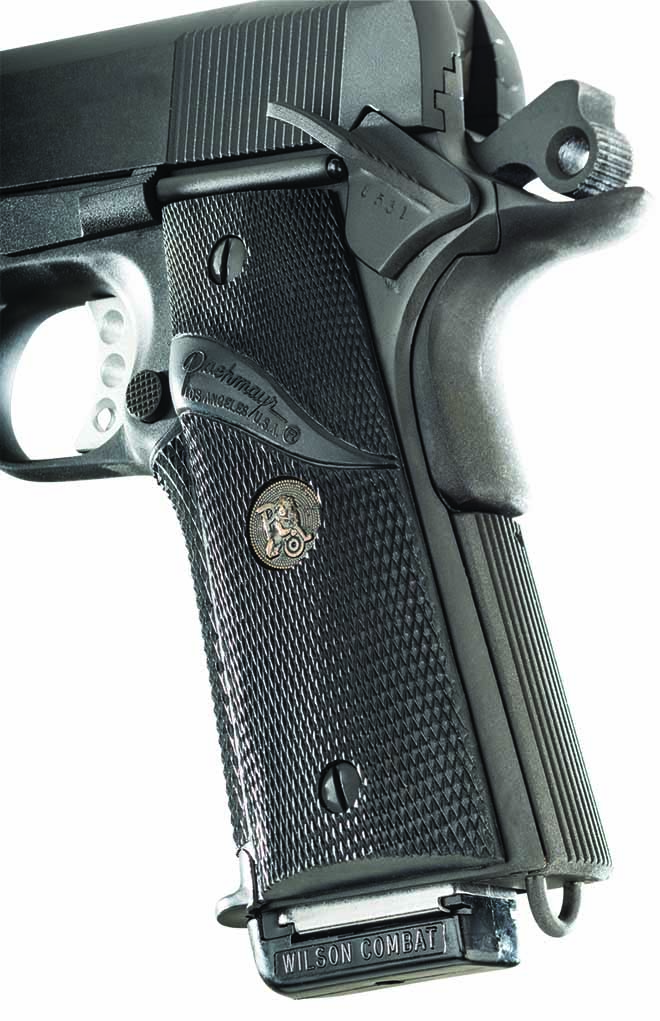
This variation was built until early 2007, when the gunsmiths switched to the Ed Brown thumb safety. There were a few of the variations that used the King safety built with Caspian receivers early on, and toward the end of production the switch was made to the Ed Brown safety. There were also a small number of both variations that were built using Caspian slides.
The Caspian slides had Novak sight cuts, front and rear flat-slated serrations, a Marine Corps emblem on both sides behind the rear serrations, and “USMC” stamped on the ejection port side. In mid-2004, the gunsmiths switched to a Caspian flat serrated mainspring housing.
At some point, an order of Springfield slides came in that were marked “OPERATOR, CAL .45” on the non-ejection port side. They also switched from the GM-45C Pachmayr to the GM-45 toward the end of this variation. C&S fire-control components replaced the MGW set with a new hammer, sear and disconnector. Night sights were never “officially” authorized for the pistol, but many of them came in for maintenance with night sights because of operator preferences.
Reliving The MEUSOC History
Like I said before, I was fascinated with the MEUSOC 1911 and, knowing I couldn’t have the real thing, I started making plans for a faithful reproduction.
The first thing I needed was an original USGI frame, so in 2005 I purchased a 1943 Colt pistol for a whopping $12.50. The frame had been sanded and cold-blued, it had an equally sanded and cold-blued Remington Rand slide — neither part had any collector value at all — so I sent the frame to Crawford and he managed to scrounge up the rest of the parts.
Crawford used my USGI receiver and added a seven-digit “hard” slide, Millett front sight, RTE manufactured rear sight, Kings 201-A ambidextrous safety, Wilson 66 beavertail, Bar-Sto semi-fit barrel and bushing, Videcki “speed” trigger, MGW commander hammer, Pachmayr grips and Wilson 47 magazines. Crawford also manufactured the mainspring housing by converting an arched USGI mainspring housing to flat and serrated, complete with a lanyard loop.
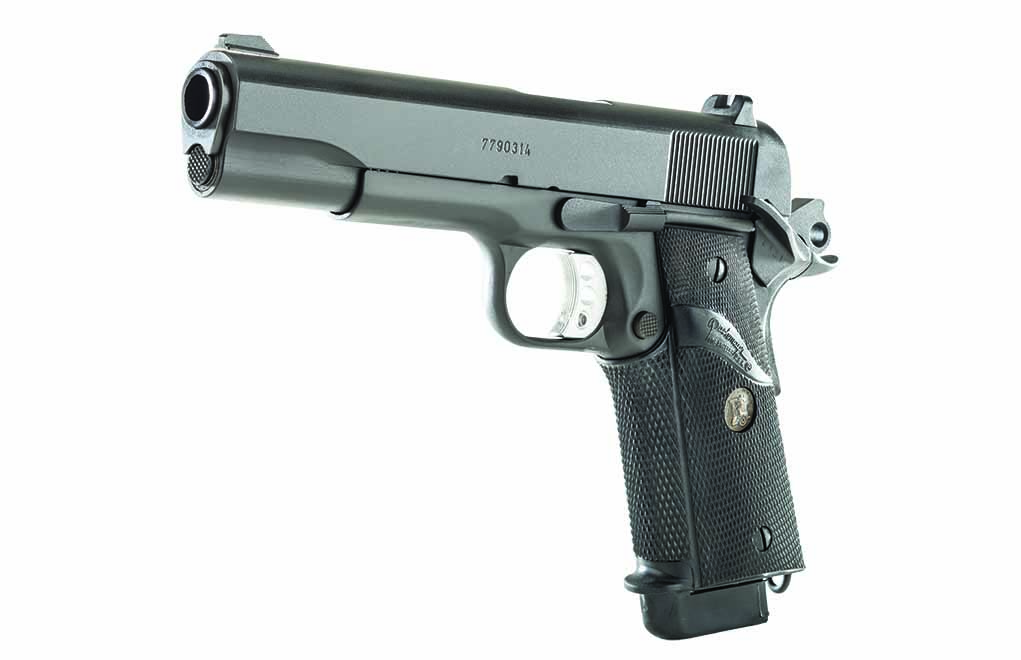
The balance of parts are a combination of multiple manufacturers, and we didn’t think we needed to be that specific for the internal parts that couldn’t be seen. After the pistol was properly fitted with the same specifications Crawford used while serving in the Marine Corps in Quantico, the pistol was finished in a manganese phosphate bath. The pistol was delivered to me with seven Wilson 47 seven-round magazines and an official USMC Weapon Record Book, where I have kept an official log of every single round fired through the pistol since I received it.
For more information on KC's Kustom Creations, please visit www.kcskustomcreations.com.
Editor's Notes: This article originally appeared in the September 2018 issue of Gun Digest the Magazine.

Next Step: Get your FREE Printable Target Pack
Enhance your shooting precision with our 62 MOA Targets, perfect for rifles and handguns. Crafted in collaboration with Storm Tactical for accuracy and versatility.
Subscribe to the Gun Digest email newsletter and get your downloadable target pack sent straight to your inbox. Stay updated with the latest firearms info in the industry.

![Best Concealed Carry Guns In 2025 [Field Tested] Wilson Combat EDC X9S 1](https://gundigest.com/wp-content/uploads/Wilson-Combat-EDC-X9S-1-324x160.jpg)


![Best 9mm Carbine: Affordable PCCs [Tested] Ruger Carbine Shooting](https://gundigest.com/wp-content/uploads/Ruger-Carbine-Shooting-100x70.jpg)
![Best AR-15: Top Options Available Today [Field Tested] Harrington and Richardson PSA XM177E2 feature](https://gundigest.com/wp-content/uploads/Harrington-and-Richardson-PSA-XM177E2-feature-100x70.jpg)
